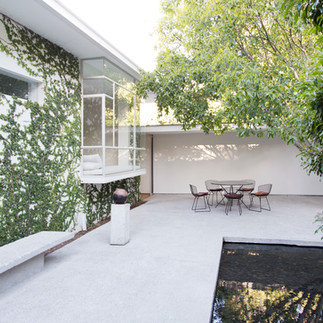The Grassless Revolution: How to Create a Stunning Yard Without a Blade of Grass
- Route 56

- Apr 13, 2023
- 3 min read
Creating a grassless yard can be a great way to save time, water, and energy while still maintaining a beautiful and functional outdoor space. In this blog post, we will explore some of the benefits of a grassless yard, as well as some practical tips for designing and maintaining one.
Why Choose a Grassless Yard?
There are several reasons why you might choose to create a grassless yard. Here are a few of the most common:
Water Conservation: Lawns require a lot of water to stay healthy and green, especially in hot and dry climates. By replacing your grass with drought-resistant plants or other landscaping features, you can significantly reduce your water usage and lower your utility bills.
Low Maintenance: Grass requires regular mowing, watering, and fertilizing to stay healthy, which can be time-consuming and expensive. By opting for low-maintenance landscaping features like gravel, mulch, or native plants, you can save time and money while still enjoying a beautiful outdoor space.
Environmental Benefits: Grass lawns require a lot of resources to maintain, including water, fertilizer, and pesticides. By reducing your reliance on these inputs, you can reduce your environmental impact and contribute to a more sustainable future.
Tips for Designing a Grassless Yard
Once you've decided to create a grassless yard, the next step is to start designing your new outdoor space. Here are some tips to help you get started:
Determine Your Needs: Before you start planting or installing hardscaping features, think about how you will be using your yard. Do you need space for kids to play, a place to entertain guests, or a quiet retreat for reading and relaxing? Make a list of your priorities so you can design a space that meets your needs.
Choose Low-Maintenance Plants: If you're incorporating plants into your grassless yard, be sure to choose species that are well-suited to your local climate and require minimal care. Native plants are often a good choice, as they are adapted to local conditions and require less water and maintenance than non-native species.
Consider Hardscaping Features: Gravel, mulch, rocks, and pavers are all great options for creating a low-maintenance, grassless yard. They require minimal upkeep and can add visual interest and texture to your outdoor space.
Incorporate Water-Saving Features: If you live in a dry climate or want to reduce your water usage, consider incorporating water-saving features like rain barrels, drip irrigation systems, or a rain garden into your yard design.
Think Beyond the Lawn: A grassless yard doesn't have to be boring or unattractive. By incorporating elements like outdoor seating, decorative lighting, or art, you can create a visually appealing space that's both functional and inviting.
Maintaining a Grassless Yard
Once your grassless yard is designed and installed, it's important to take proper care of it to ensure it remains healthy and beautiful. Here are some tips for maintaining a grassless yard:
Water Wisely: If you've incorporated plants into your yard, be sure to water them deeply and infrequently to encourage deep root growth. Watering in the early morning or evening can also help reduce water loss due to evaporation.
Control Weeds: Weeds can be a problem in any yard, but they can be especially challenging in a grassless yard. To prevent weeds from taking over, use a combination of hand weeding, mulching, and weed barriers.
Refresh Mulch and Gravel: Over time, mulch and gravel can break down and become compacted. To keep your yard looking fresh and tidy, consider adding a new layer of mulch or gravel every year or two.
Prune Regularly: If you've incorporated trees or shrubs into your yard, be sure to prune them regularly to maintain their shape and prevent overgrowth. Pruning can also help improve air circulation and sunlight penetration, which can promote plant health.
Address Drainage Issues: If your yard is prone to standing water or flooding, it's important to address these drainage issues to prevent damage to your landscaping and hardscaping features. Consider installing a French drain or rain garden to redirect water away from your yard.
Clean Hardscaping Features: Gravel, mulch, and other hardscaping features can collect debris and become discolored over time. To keep these features looking their best, use a leaf blower or broom to remove debris and rinse them off with a hose as needed.
Adjust for Seasonal Changes: Depending on where you live, your grassless yard may require different care throughout the year. In the summer, for example, you may need to water more frequently or provide shade for sensitive plants. In the winter, you may need to protect your plants from frost or snow.
Conclusion
Creating a grassless yard can be a great way to save time, water, and energy while still enjoying a beautiful and functional outdoor space. By designing your yard with low-maintenance plants, hardscaping features, and water-saving elements, you can create a space that's both environmentally friendly and visually appealing. And with proper maintenance, your grassless yard can continue to thrive for years to come.












Comments